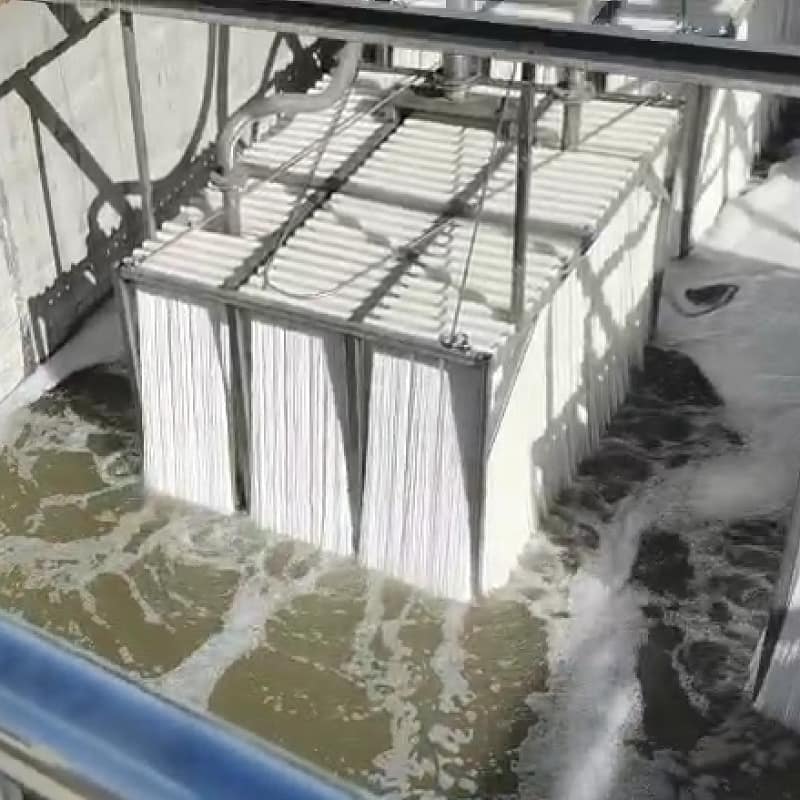MBR (Membrane Bioreactor) technology represents a significant leap forward in advanced wastewater treatment by combining membrane separation with biological processes. To ensure optimal performance and longevity, it is essential to set up and commission the MBR membrane modules correctly. In this guide, we detail the environmental requirements, proper module setup, and the startup procedures for MBR systems.
1. Preparing the MBR Environment
A. Proper Connections and Pre-Installation Checks
Before installing the MBR modules, verify that all wastewater and air supply lines are correctly connected. Any misconnection must be rectified immediately to prevent operational issues. Additionally, ensure that the membrane modules are securely fastened in the aeration tank. This helps prevent vibrations or shifting during operation.
B. Clean Reaction Tank
A clean reaction tank is crucial. Thoroughly wash the tank to remove dust, soil, and other debris that might damage the membranes. A clean environment minimizes the risk of contaminant-induced membrane fouling.
C. Air Removal Procedure
Prior to filling the reaction tank with water (either clean water for testing or feed water), open the air release valves to completely expel any trapped air within the MBR modules. Once the tank reaches the designated water level, close these valves to maintain proper hydraulic conditions.
2. Commissioning with Clean Water
A. Aeration and Flow Testing
After starting the blower, check the uniformity of airflow across all MBR modules. During the clean water test, a slight amount of foam may appear due to residual hydrophilic materials on the membranes—this is normal. If a single blower supplies multiple modules, ensure that each module receives an equal volume of air. In cases of uneven air distribution, inspect the piping configuration and adjust accordingly.
B. Monitoring Control Equipment
During clean water commissioning, carefully observe the performance of control equipment. Verify that the system operates according to design specifications. Record key parameters such as flow rates (maximum and minimum), transmembrane pressure (TMP), and water temperature. These records are critical for troubleshooting and future maintenance.
C. Ending the Clean Water Test
Once the clean water test is complete, promptly cease both aeration and filtration operations to prepare for the next phase.
3. Seeding with Activated Sludge
Before switching to full-scale operation with actual wastewater, the MBR modules must be seeded with activated sludge. Directly processing raw water without proper seeding can lead to rapid membrane fouling. Consider the following steps for effective sludge seeding:
- Preparation: Use activated sludge from a similar wastewater treatment process with an MLSS concentration of around 20,000 mg/L.
- Initiate Feed: After seeding, begin introducing raw water that has been pre-treated using a fine-mesh screen (with an opening of less than 5mm) to remove coarse contaminants.
- MLSS Adjustment: Aim to achieve an MLSS concentration above 7000 mg/L without using additional inoculants. Proper seeding ensures a stable biological process and minimizes the risk of fouling from unreacted organic matter.
4. Starting the System and Ongoing Operation
After completing the pre-checks and seeding, start the aeration process and initiate wastewater filtration. During operation, continuously monitor critical parameters such as:
- Transmembrane Pressure: To detect early signs of fouling.
- Water Temperature: To ensure optimal conditions for microbial activity.
- Flow Rates: To maintain consistent system performance.
Accurate recording of these parameters facilitates easier future maintenance, troubleshooting, and system optimization. Should any issues arise during startup, address them immediately to ensure continued efficient operation.
5. Important Operational Reminders
To achieve the best performance from your MBR system, it is essential to:
- Follow the outlined pre-operation checks and commissioning procedures without shortcuts.
- Avoid unauthorized modifications to the setup process.
- Establish a regular maintenance schedule based on recorded operational data to ensure the longevity of the membrane modules.
By adhering to these guidelines, you can ensure that your MBR membrane modules operate at peak efficiency, delivering consistent, high-quality wastewater treatment.
Conclusion
In summary, the successful implementation of Membrane Bioreactor (MBR) systems hinges on meticulous attention to environmental prerequisites, precise commissioning protocols, and diligent operational practices. Ensuring optimal raw water quality, executing thorough pre-treatment processes, and adhering to detailed membrane module commissioning steps are vital for achieving peak performance and longevity of the MBR system.
By following these comprehensive guidelines, operators can enhance the efficiency and reliability of their wastewater treatment processes. For specialized assistance or further information on MBR membrane solutions, please contact RANDL ENVIRONMENT.

